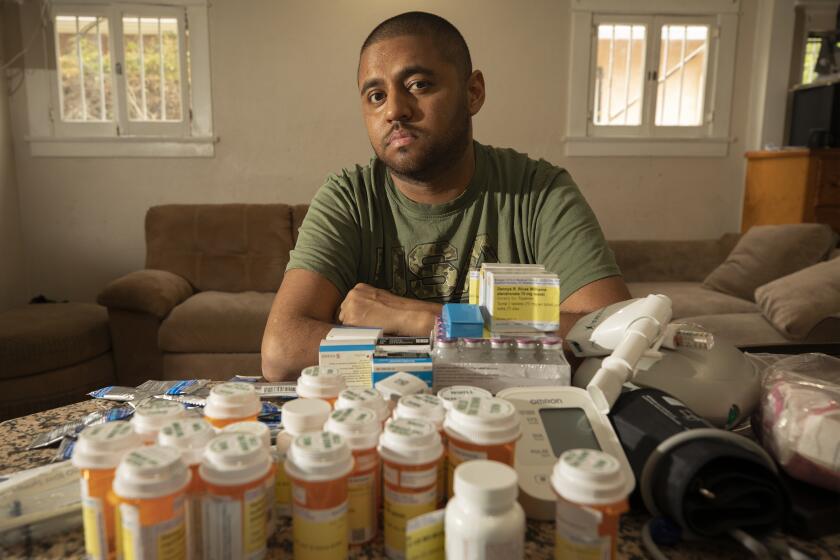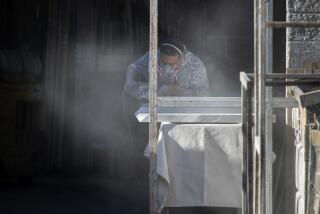Safer stone? New countertop options emerge amid concerns over silicosis and worker deaths
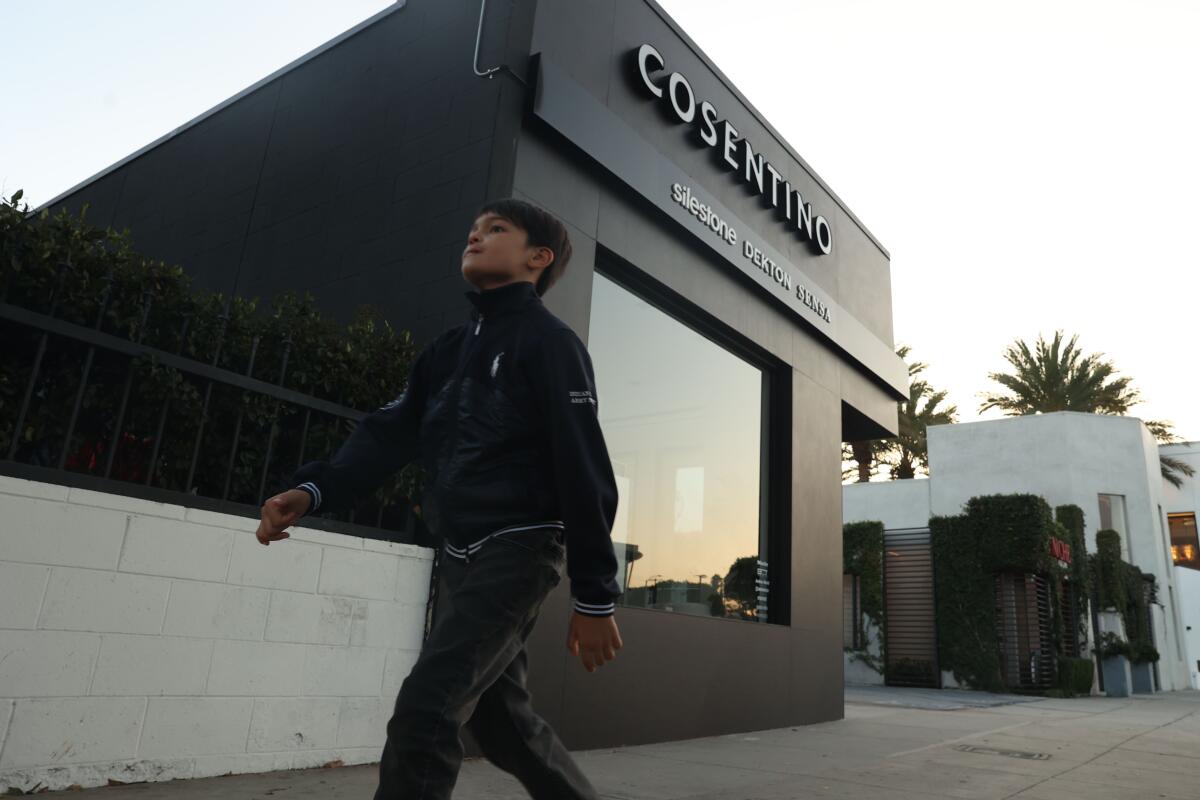
- Share via
- Engineered stone high in crystalline silica, which can damage the lungs when inhaled, has faced growing scrutiny as countertop cutters have grown ill and died from silicosis.
- Some companies that make engineered stone for kitchen and bath countertops have started marketing new, reduced-silica products.
- Scientists in Australia, where engineered stone has been broadly banned, have cautioned that crystalline silica may not be the only component of the slabs that could pose safety concerns.
Companies that manufacture slabs of engineered stone, a popular choice for kitchen and bathroom countertops, are developing and marketing new products amid mounting concerns about stonecutters being sickened with a deadly lung disease.
The new alternatives boast reduced levels of crystalline silica, a mineral that can cause an incurable disease called silicosis if workers inhale tiny particles of dust from cutting and grinding stone.
Doctors have linked a global eruption of severe silicosis among young stonecutters to the booming popularity of engineered stone, which can contain upward of 90% crystalline silica. In California, health officials have confirmed 180 cases of silicosis among countertop cutters in less than six years, resulting in at least 13 deaths.
Engineered stone manufacturers say their slabs can be cut safely with proper precautions and that shoddily run workplaces — not their products — are to blame. But amid legal battles and calls to ban engineered stone, some companies have also begun offering newer products that are lower in crystalline silica.
Such alternatives have rapidly hit the market in Australia, where government regulators recently banned the installation of engineered stone. Dr. Ryan Hoy, senior research fellow at Monash University’s Centre for Occupational and Environmental Health in Melbourne, said that many of the new products are made with a form of silica from recycled glass that is “far less toxic than the crystalline form.”
He cautioned, however, that such slabs may still have other dangerous elements. “There is definitely urgent need for further toxicological testing,” Hoy said, but in light of the known harm that workers have suffered from crystalline silica, “I think transition to these is reasonable rather than delaying it.”
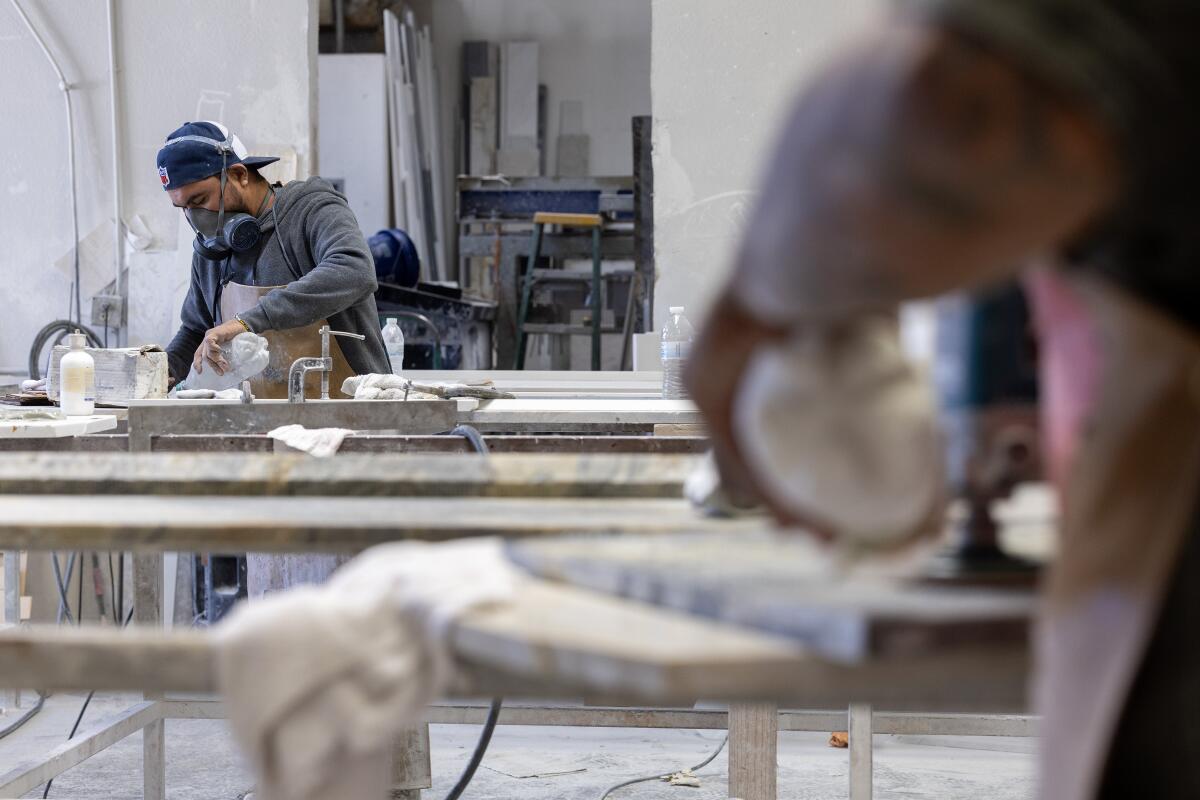
The global market for engineered stone, a product prized by customers for its durability, generally lower pricing and wide variety of colors and patterns, has been valued at roughly $25 billion by market researchers.
Marcos Santa Ana, president of the Southern California design-build firm Alloi, said he could recall just one client in recent years who had brought up concerns about silica content and asked about alternatives: an Australian who instead opted for a birch countertop.
Turning to new products gives engineered stone companies a way to stay on the market in Australia. Under rules adopted there, engineered stone — a product made by combining stone materials with chemical constituents such as resins and pigments — can still be used if it has less than 1% crystalline silica. Workplace safety officials in Australia said legal alternatives also include some products made of porcelain or “sintered stone,” an artificial product made by binding minerals together with heat.
The grinding and sanding of synthetic engineered stone exposes workers to high levels of lung-scarring silica. Experts say the health risk should have been clear long before workers began falling ill.
But the engineered stone industry has also been advertising products with lower levels of silica beyond the Australian market. One major company with headquarters in Spain, Cosentino, now manufactures its Silestone slabs with 40% crystalline silica or less and also has a range of products with 10% or less of the mineral.
Cosentino said in an email that it had launched research on technology that helped reduce the crystalline silica content of its products more than seven years ago, well before any ban. In Australia, where 10% crystalline silica is still above the limit for engineered stone, it sells slabs made of other materials such as porcelain.
Another company, Israel-based Caesarstone, is now marketing a “Crystalline-Silica Free” collection in Australia that contains less than 1% crystalline silica, according to its safety data, and said it plans to unveil similar offerings in the U.S. Its subsidiary Caesarstone USA said in a written statement that such products “are part of our broader commitment to leading the industry towards safer, more sustainable practices.”
Caesarstone USA said it also has an existing “low silica” line with less than 40% crystalline silica already available in the U.S. And the company added that it is now “developing new products with less than 1% crystalline silica, which are expected to offer even greater safety benefits,” although “the success of these products in development and their market demand are still unclear.”
Dr. Robert Harrison, a professor of occupational medicine at UC San Francisco, said he had not seen so many cases of severe and deadly silicosis until artificial stone countertops rife with crystalline silica hit the market.
“The jury is still out on whether these [new] products are completely safe,” Harrison said, “but they are probably safer than the products containing crystalline silica that we’re selling now in the United States.”
Crystalline silica ravages the lungs by scarring them from within. Scientists from the National Institute for Occupational Safety and Health presented research at a national conference this year that concluded that it was likely that the harmful effects suffered by countertop cutters were “primarily driven” by the crystalline silica content of the material they were cutting and grinding.
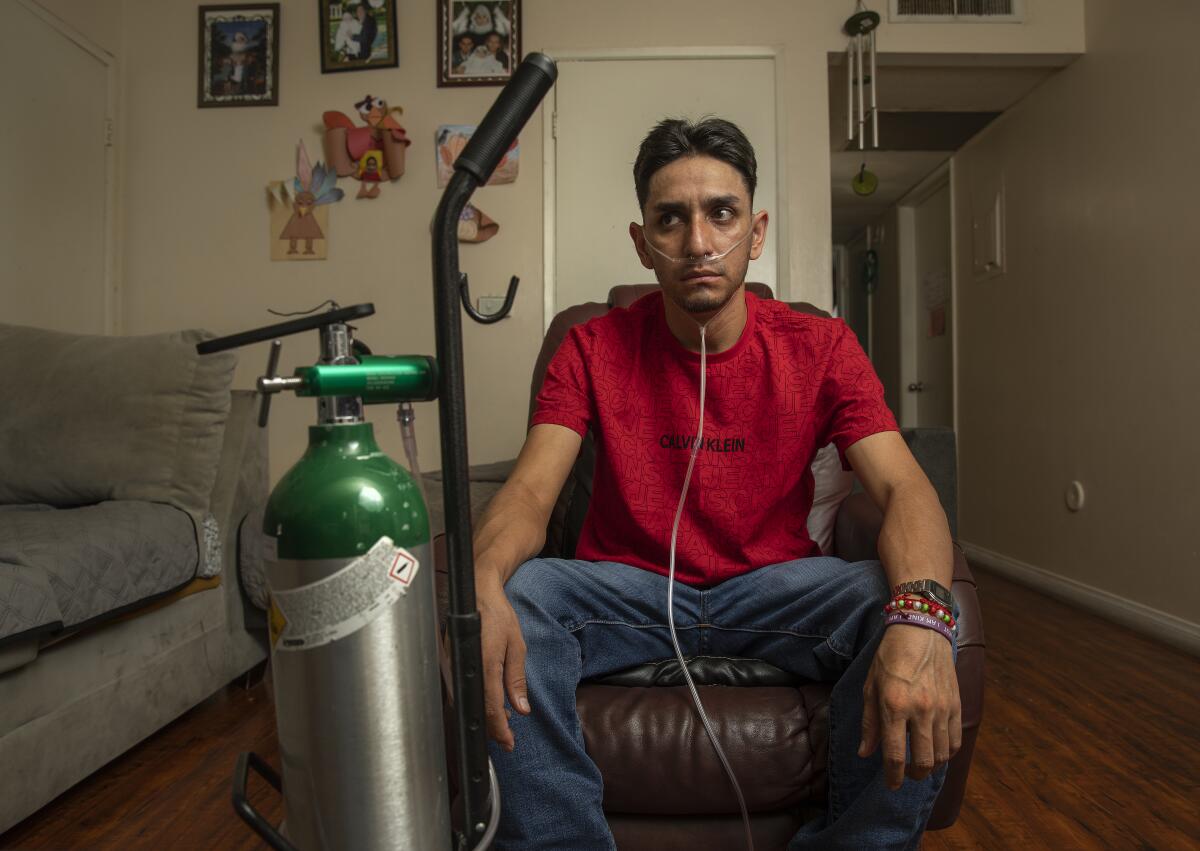
But when researchers at the University of Adelaide and the University of Tasmania examined how lung cells were affected by dust from stone products — including some reduced silica versions of engineered stone — the results suggested “silica was not the only component that was problematic,” said Chandnee Ramkissoon, a University of Adelaide research fellow in public health.
Among the other concerns Ramkissoon and her colleagues have flagged are metals such as aluminum, as well as resins that can emit volatile organic compounds when slabs are cut. They also noted that although the “reduced silica” slabs did indeed give off less crystalline silica when they were cut, the silica particles tended to be very fine. That has health implications because tinier particles can penetrate deeper into the lungs.
“It’s enough to raise questions about whether they are actually much safer,” Ramkissoon said.
Cosentino said it had commissioned research from the Instituto de Tecnologia Ceramica in Spain, which found one of its “low silica” slabs emitted less crystalline silica than natural granite and had similar amounts of metals such as aluminum and tin.
The slab didn’t give off detectable amounts of any “toxic organic compound” when cut, nor were there “relevant differences in particle sizes,” according to a Cosentino summary. A representative of the Spanish institute said that under its privacy policy, it could not provide any information about the unpublished findings.
Cosentino and industry groups have also stressed that no matter the material, safe methods need to be employed. Any kind of stone produces dust when cut, so “adhering to proper safety practices is critical, irrespective of the type of material,” said Marissa Bankert, executive director of the International Surface Fabricators Assn., which represents businesses that cut and polish slabs.
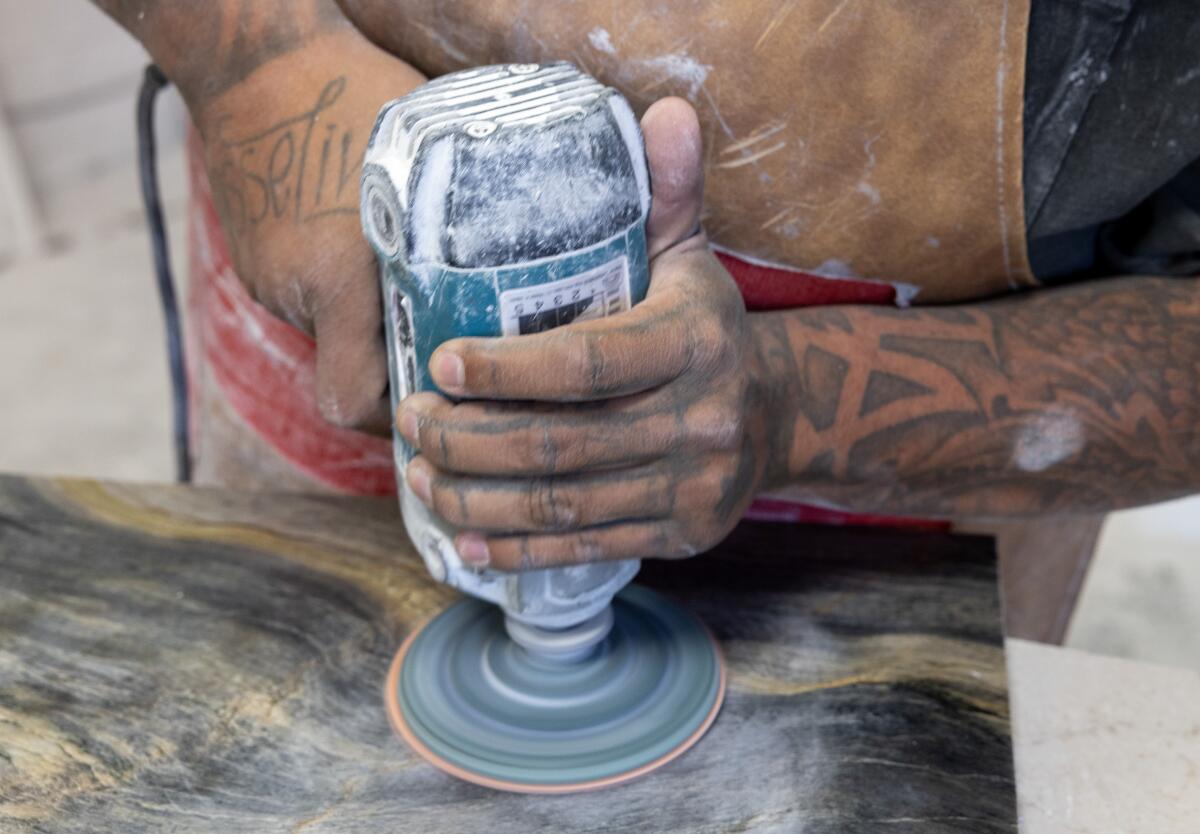
So far, California regulators have held off on the idea of banning engineered stone, instead deciding to impose stricter rules for workplace safety. A state bill setting up a licensing system for stonecutting shops was pulled back this July by its author, who said state regulators were not receptive to the idea.
Without such a system to track stonecutting shops, Assemblywoman Luz Rivas (D-North Hollywood) said there is no way to properly enforce any safety rules. In its absence, she said, the current tack by California regulators “is simply using workers as guinea pigs to find out after the fact” if their efforts save lives.
Asked about the new products lower in silica, Rivas expressed caution. “If these low-silica engineered stones continue to result in an uptick of silicosis among workers,” she said, “then I believe a ban is the right place to be.”
In the wake of the Australian ban, there have been calls in the United Kingdom and elsewhere to follow suit. Industry groups have staunchly opposed that idea: Agglomerated Stone Manufacturers Assn. director Beatrice Barbiero said that “any engineered stone is safe if the proper occupational health and safety regulations and requirements are adhered to.”
As California sees surging numbers of young workers suffering from silicosis, many have had trouble tapping workers’ compensation.
Engineered stone companies are facing a torrent of lawsuits from workers debilitated by silicosis. In California, a jury found engineered stone companies at fault this summer in a suit brought by Gustavo Reyes Gonzalez, a 34-year-old countertop cutter who had to undergo a double lung transplant.
Much of that trial revolved around whether the blame should lie with the dusty workshops in Orange County where he labored or with the companies behind the artificial slabs. In a legal filing submitted during that case, Georgia Tech scientist Jenny Houlroyd opined that neither wet cutting nor wearing masks — commonly recommended safeguards — would make engineered stone safe to cut.
Houlroyd said in an interview that the newer products need more study. “It would be wonderful,” she said, “if it were proven that it reduces the risk for workers. But as a scientist, I’d like to see that data.”
More to Read
Sign up for Essential California
The most important California stories and recommendations in your inbox every morning.
You may occasionally receive promotional content from the Los Angeles Times.

